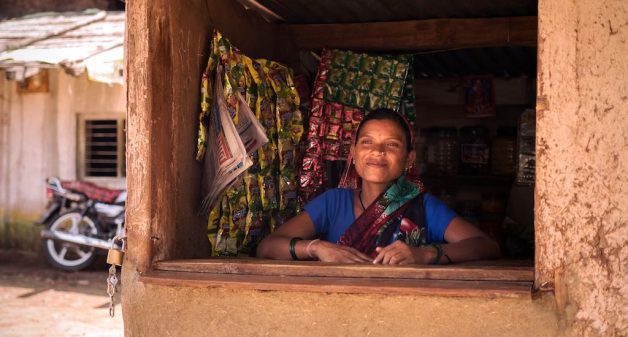On April 28, the Prime Minister’s Office announced that every village in India has been officially electrified. Although it is a remarkable milestone, it doesn’t mean electricity is available in every Indian home; nor does it mean that those reached by the central grid enjoy a reliable and modern service. Recognizing this issue, the government has now committed to provide electricity 24×7 in each and every household by March 2019.
As the pace of electrification ramps up, this milestone is an opportunity to reflect on how the socio-economic benefits from electrification redistribute among members of the communities. Particularly, how these are shared among people of different caste and religion, varying levels of education and wealth, differing cultural contexts such as patriarchy, and most importantly gender.
Rural Indian women are often disadvantaged: only 58% are literate compared to 78% of their male counterparts. Their social and political participation is often limited and although women primarily perform agriculture, only 13% own the land they cultivate. Likewise, women from patriarchal cultures face systemic subordination, lack authority and autonomy in the house, and are discouraged from making decisions independently.
Women and energy
With all this in mind, a larger question emerges: how can we ensure meaningful engagement of women and girls as the country progresses towards the provision of modern, reliable and affordable energy services to all by the year 2030?
We recently completed a study, which looked at sustainability of community-owned Solar Micro-Grids (SMGs) in 24 tribal villages in the states of Maharashtra, Karnataka and Jharkhand. The SMGs reached some of the remotest tribal communities in India, often located in protected forested areas where central grid extensions are technically challenging and expensive.
Financed via one-time grants and donations, the grids provide continuous electricity supply in houses and public places and empower members of the local communities, as they become the financial owner and manager of the installations. A locally elected village committee establishes roles, and meets monthly to discuss issues around the management of the plant.
A local operator performs basic troubleshooting to detect technical issues and collects monthly electricity tariffs from each house. A local NGO provides social interaction with the villages and capacity building activities, whereas Gram Oorja, a social enterprise based in Pune, provides technical installation, offers training to the local operator, besides ongoing technical support.
Many insights
The study provided several insights on the process of women empowerment from energy access and some of the barriers encountered.
Talking with the women in the villages, it was clear how electricity had changed their lives in unexpected ways at times, as exemplified by this testimony: “I can definitely sleep much better at night,” said a local resident in the village of Raksha, a community of 48 households in the forest reserve of Melghat in Maharashtra. “I used to worry so much when I could not feel my baby sleeping next to me but now I can just turn on the light to check if he is okay.”
Wellbeing improvements and sense of an easier life for women were considerable, as they saved time for daily chores, were able to move more freely and visit friends in the evenings and reach out to their families, thanks to mobile phones. Some ventured so far as to say they had become “lazy” compared with how they lived before electricity arrived.
Showcasing leadership
The village committees in particular provided an opportunity for women members to showcase leadership in the day-to-day governance of the SMG. Where present, self-help groups did not only facilitate woman political empowerment but also increased the overall sustainability of the systems, as women’s organizational skills resulted in more effective forms of governance, and a more rigorous process for tariff collection, and enforcement of rules and penalties.
“I am the treasurer of this committee,” a woman said proudly in the village of Bhinjpur in Gumla district in Jharkhand. “I am proud of my work and people in the village respect me for that. We hold meetings every two weeks. We go to each household and tell them a day in advance about the meeting. I bring women with me to meetings and everybody raises topics for discussion.”
Sense of responsibility
A strong sense of duty and responsibility also emerged. “The breakdown of the plants makes us lose heart and alienates us from the good books of the people. We get stressed and sometimes want to escape from the responsibility altogether.” Describing the time management challenges she said, “Due to the extra responsibility of being in the Village Committee, the time we devote to agriculture is reduced as we are often busy in meeting and other tasks.”
Empowerment of women is much harder to achieve than improvements in their wellbeing. The political empowerment of those women involved in the local committees was restricted to villages where the local NGO actively encouraged female participation.
There was little change in women power at home with decision-making authority retained by the male head of the family. He ultimately had the final say, even for matters such as purchase of appliances. We also observed little economic opportunities for women arising from energy access.
What can we do next?
The narrative found during the study is confirmation that energy access alone does not immediately or organically result in the empowerment of women and girls. While signs of empowerment may take longer to emerge, it is important to reflect on the more immediate actions that could be undertaken to support this process.
To begin with, operational level stakeholders, including the local NGOs, solution providers and funders, all play a key role in promoting equal distribution of benefits among members of the communities. Supporting capacity building activities to encourage productive use of electricity among women’s groups and individuals could be a starting point.
Many women, despite having the same knowledge as their husbands, often face cultural barriers that prevent them from benefitting from opportunities such as joining the local energy committee, becoming operators of the solar plant, or start a business.
Crucial issues
These issues are crucial and should be addressed during the initial phase of social interaction. Involvement of both men and women at all stages of the installation should actively be sought, taking into account the difference in preferences and seeking their involvement during construction and training to maintain the plant.
Measuring and tracking female empowerment is a challenging task, not least because the very definition of empowerment is often still open to debate. Empowerment spans dimensions, involving the private, public, and social sphere of individuals at many levels.
The intrinsic difficulties of conceptualizing female empowerment are no excuse to ignore the effects that social development interventions have in promoting equity and closing the differentiated gender opportunity gap. Keeping in mind the gender dimension of energy access is therefore an imperative to achieve 100% electrification in a manner that is not only technically sustainable, but also meaningful and inclusive.
Arianna Tozzi is a Sustainable Energy Consultant and Researcher based in Pune, India. Views are personal.
Aparna Katre is Assistant Professor of Cultural Entrepreneurship at the University of Minnesota in the US and associate at the Institute on the Environment. Views are personal.








